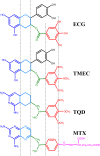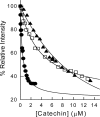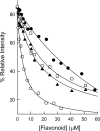Binding of natural and synthetic polyphenols to human dihydrofolate reductase
- PMID: 20054477
- PMCID: PMC2802001
- DOI: 10.3390/ijms10125398
Binding of natural and synthetic polyphenols to human dihydrofolate reductase
Abstract
Dihydrofolate reductase (DHFR) is the subject of intensive investigation since it appears to be the primary target enzyme for antifolate drugs. Fluorescence quenching experiments show that the ester bond-containing tea polyphenols (-)-epigallocatechin gallate (EGCG) and (-)-epicatechin gallate (ECG) are potent inhibitors of DHFR with dissociation constants (K(D))of 0.9 and 1.8 microM, respectively, while polyphenols lacking the ester bound gallate moiety [e.g., (-)-epigallocatechin (EGC) and (-)-epicatechin (EC)] did not bind to this enzyme. To avoid stability and bioavailability problems associated with tea catechins we synthesized a methylated derivative of ECG (3-O-(3,4,5-trimethoxybenzoyl)-(-)-epicatechin; TMECG), which effectively binds to DHFR (K(D) = 2.1 microM). In alkaline solution, TMECG generates a stable quinone methide product that strongly binds to the enzyme with a K(D) of 8.2 nM. Quercetin glucuronides also bind to DHFR but its effective binding was highly dependent of the sugar residue, with quercetin-3-xyloside being the stronger inhibitor of the enzyme with a K(D) of 0.6 microM. The finding that natural polyphenols are good inhibitors of human DHFR could explain the epidemiological data on their prophylactic effects for certain forms of cancer and open a possibility for the use of natural and synthetic polyphenols in cancer chemotherapy.
Keywords: antifolates; dihydrofolate reductase; enzyme inhibition; flavonoids; polyphenols; tea catechins.
Figures








References
-
- Mukhtar H, Ahmad N. Tea polyphenols: Prevention of cancer and optimizing health. Am. J. Clin. Nutr. 2000;71:1698S–1702S. - PubMed
-
- Fujiki H, Sugunuma M, Imai K, Nakachi K. Green tea: Cancer preventive beverage and/or drug. Cancer Lett. 2002;188:9–13. - PubMed
-
- Hamilton-Miller JMT. Anti-cariogenic properties of tea (Camellia Sinensis) J. Med. Microbiol. 2001;50:299–302. - PubMed
-
- Yam TS, Hamilton-Miller JMT, Shah S. The effect of a component of tea (Camellia Sinensis) on methicillin resistance, PBP2′ synthesis, and beta-lactamase production in Staphylococcus Aureus. J. Antimicrob. Chemother. 1998;42:211–216. - PubMed
Publication types
MeSH terms
Substances
LinkOut - more resources
Full Text Sources
Other Literature Sources

